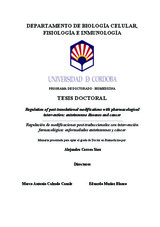Mostrar el registro sencillo del ítem
Regulation of post-translational modifications with pharmacological intervention: autoimmune diseases and cancer
| dc.contributor.advisor | Calzado Canale, Marco Antonio | |
| dc.contributor.advisor | Muñoz Blanco, Eduardo | |
| dc.contributor.author | Correa‑Sáez, Alejandro | |
| dc.date.accessioned | 2022-12-21T13:02:01Z | |
| dc.date.available | 2022-12-21T13:02:01Z | |
| dc.date.issued | 2022 | |
| dc.identifier.uri | http://hdl.handle.net/10396/24456 | |
| dc.description.abstract | Post-Translational Modifications are key elements within the cell signalling pathways. These key events promptly reprogram protein's behaviour in presence of environmental alterations in a highly dynamic manner acting as regulators or even on/off switches. The DNA Damage Response (DDR) is triggered after the genomic material is compromised to either induce cell death and prevent tumorigenesis or cell cycle arrest to fix the damaged DNA. To induce cell cycle arrest, an extensive network of enzymes acts coordinately to phosphorylate the CDKs. It is widely believed that the DDR and the cell cycle control pathways are highly interconnected. Therefore, any alteration in the enzymes in charge of this process might trigger carcinogenesis by any of both pathways. Besides, the hypoxic response is another distinctive characteristic in many diseases and its pharmacological modulation is of great relevance in Huntington's treatment. In the present work, first, we show that DYRK2 is found in the interface between the DDR and the cell cycle control. We demonstrate that DYRK2 can phosphorylate and induce the proteasomal degradation of the proteins NOTCH1 and CDC25A. On the one hand, we proved that DNA damage triggers DYRK2 ability to reduce the effects of NOTCH1 in cell migration. On the other hand, DYRK2 was described as a key kinase controlling CDC25A stability throughout the cell cycle, thus determining the cell cycle phase transitions. Besides, we showed the ability of Betulinic Acid Hidroxymate (BAH) to activate the HIF pathway by reducing the PHD2 phosphorylation on Ser125 with clear implications for the treatment of Huntington´s disease. The description of NOTCH1 and CDC25A as new DYRK2 substrates established this kinase as a master modulator linking the DDR pathway and the cell cycle control. Again, this relation is tightly controlled by PTMs reinforcing their role as modulators of the cell signalling pathways. Finally, the understanding of the BAH action mechanism might drive further pharmacologic efforts into the development of more potent drugs to target PHD2 increasing HIF-1α stabilization. | es_ES |
| dc.description.abstract | Las modificaciones postraduccionales son elementos clave dentro de las vías de señalización celular para reprogramar rápidamente el comportamiento de las proteínas en presencia de alteraciones ambientales de forma muy dinámica, actuando como reguladores o incluso como interruptores de encendido/apagado. La respuesta al daño en el ADN (DDR) se desencadena después de que el material genético se vea comprometido, ya sea para inducir la muerte celular y evitar la tumorigénesis o para detener el ciclo celular y arreglar el ADN dañado. Para inducir la detención del ciclo celular, una amplia red de enzimas actúa de forma coordinada para fosforilar las proteínas CDK. La vía de señalización DDR y las vías de control del ciclo celular están muy interconectadas. Por lo tanto, cualquier alteración en las enzimas encargadas de este proceso podría desencadenar la carcinogénesis por cualquiera de ambas vías. Además, la respuesta hipóxica es otra característica distintiva en muchas enfermedades y su modulación farmacológica es de gran relevancia en el tratamiento de Huntington. En el presente trabajo, en primer lugar, mostramos que DYRK2 se encuentra en la interfaz entre el DDR y el control del ciclo celular. Demostramos que DYRK2 puede fosforilar e inducir la degradación proteasomal de las proteínas Notch1-IC y CDC25A. Por un lado, demostramos que el daño al ADN desencadena la capacidad de DYRK2 para reducir los efectos de NOTCH1 en la migración celular. Por otro lado, DYRK2 se describió como una quinasa clave que controla la estabilidad de CDC25A a lo largo del ciclo celular, determinando así las transiciones de fase del ciclo celular. Además, demostramos la capacidad del Ácido Betulínico Hidroxamato (BAH) para activar la vía HIF reduciendo la fosforilación de PHD2 en Ser125, con claras implicaciones para el tratamiento de la enfermedad de Huntington. La descripción de NOTCH1 y CDC25A como nuevos sustratos de DYRK2 sitúa a esta quinasa como un modulador esencial que vincula la vía DDR y el control del ciclo celular. De nuevo, esta relación está estrechamente controlada por PTMs reforzando su papel como moduladores de las vías de señalización celular. Por último, la comprensión del mecanismo de acción del BAH podría impulsar nuevos esfuerzos farmacológicos para el desarrollo de fármacos más potentes dirigidos a que la proteína PHD2 aumente la estabilización de HIF-1α. | es_ES |
| dc.format.mimetype | application/pdf | es_ES |
| dc.language.iso | eng | es_ES |
| dc.publisher | Universidad de Córdoba, UCOPress | es_ES |
| dc.rights | https://creativecommons.org/licenses/by-nc-nd/4.0/ | es_ES |
| dc.subject | Autoimmune diseases | es_ES |
| dc.subject | Cancer | es_ES |
| dc.subject | Post-Translational Modifications | es_ES |
| dc.subject | Tyrosine-regulated kinase 2 (DYRK2) | es_ES |
| dc.subject | Pharmacological inhibition | es_ES |
| dc.subject | Phosphorylation | es_ES |
| dc.subject | NOTCH1 | es_ES |
| dc.subject | CDC25A | es_ES |
| dc.subject | Betulinic Acid Hidroxymate | es_ES |
| dc.subject | Cell cycle | es_ES |
| dc.subject | Molecular biology | es_ES |
| dc.title | Regulation of post-translational modifications with pharmacological intervention: autoimmune diseases and cancer | es_ES |
| dc.title.alternative | Regulación de modificaciones post-traduccionales con intervención farmacológica: enfermedades autoinmunes y cáncer | es_ES |
| dc.type | info:eu-repo/semantics/doctoralThesis | es_ES |
| dc.rights.accessRights | info:eu-repo/semantics/openAccess | es_ES |

